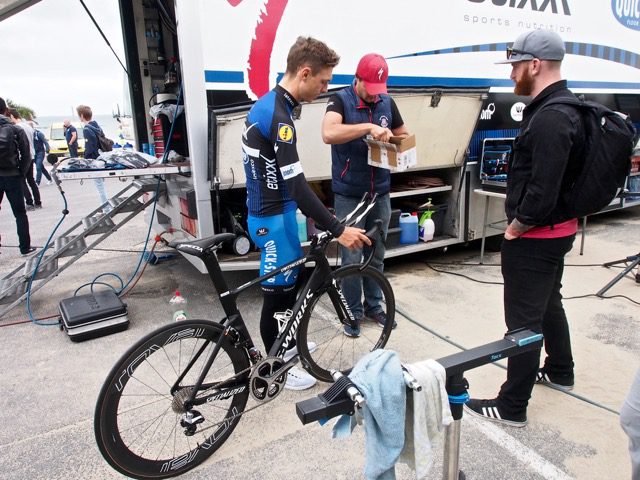Uphill Tour de France time trial presents particular challenges to Specialized aerodynamicists
Chris Yu preps Tony Martin ahead of the 17-km time trial on Stage 18

Tony Martin of Etixx-QuickStep is a three-time individual time trial world champion and arrived at the 2016 Tour de France with designs on Stage 13’s flat 37-km time trial. With only one time trial win in 2016 at the German national championships, the Panzerwagen finished a disappointing ninth on that day.
On the second Tour de France rest day, riders were already looking to the 17-km uphill time trial on Stage 18. The first 4 km of the course are relatively flat. After an 11-km climb, the final 2 km are downhill. With the help of Specialized aerodynamicist Chris Yu, Canadian Cycling Magazine got an inside look into how Martin, a 31-year-old rider who spent Stage 16 in the breakaway with teammate Julian Alaphilippe, is preparing for the challenging time trial.
“It’s interesting because it has a little bit of flat and climbing so the equipment optimization is more important compared to a purely flat or climbing time trial,” said Specialized aerodynamics specialist Chris Yu who was in the process of perfecting Martin’s setup. “We are working with the team mechanics and staff to figure out what the best equipment selection is for the riders. We will run simulations, take input from the team on different components and make recommendations. Coming out of that, we have a pretty good idea of what the optimal set up is.”
Preparation for these stages begins before the Tour. With the announcement of the course, Yu said Specialized began to think about what sort of setups would be optimal for riders on these stages.
“Before the race is a good time to test everything to make sure it is all OK with the riders because at the end of the day, they have to be OK with the setup,” said Yu. “This is Plan A right now: it’s our Venge Vias aero road bike but it is set up custom for the flat parts with clip-on aero bars.”
The Venge Vias’s aerodynamic performance is allegedly on par with Specialized’s time trial bike on a course such as Stage 18’s. Because the Venge is built lighter and has a more comfortable climbing position with its hoods, riders can adjust their position on the steep parts of the climb.
The one thing that could change a rider’s mind at the last minute is if wind conditions change. By running simulations of the course, Specialized is able to consult with teams and riders to give them recommendations of what sort of equipment they expect to be fastest on any given day.
These simulations start a couple of weeks before the Tour. “We tested the riders in the wind tunnel and out on the track during the off-season so we know their numbers ahead of the season,” said Yu. “We can run through the different iterations and advice the riders based off of our simulations.”
Yu and others are at the Tour in an advisory role. Riders vary in regard to how much they want to change their setups, which are very personalized. Yu said Martin is very responsive to data, but as a world-class rider, he also knows what sort of gear he likes to use after years of success at the top level of the sport.
Andre Cheuk contributed to this story.




